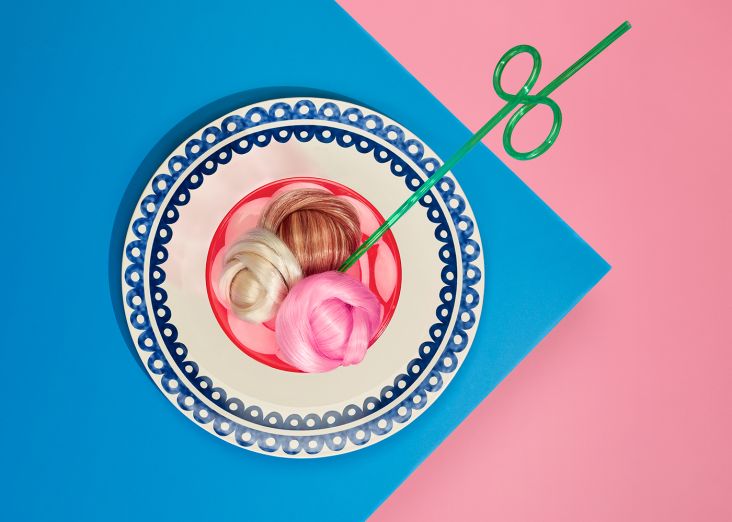How to turn a stranger into a client in four simple steps
Are you struggling with your marketing? Do you find it difficult to reach out and get clients? Or do you do the opposite: become pushy, so you scare your potential clients away? (Maybe because you are a bit shy, and don’t know how marketing and selling works?)

Image licensed via Adobe Stock
Or are you going to loads of networking events or using social media, but don’t get anything as a result? The reality is that it takes time, patience, creativity and a bit of persistence and strategy to market your creative products and services, especially if you're still relatively new.
My name is Patricia van den Akker, the Director of The Design Trust, an online business school for designers and makers based in London. I have been working as a creative business adviser, trainer and coach for over 15 years. Although I had a lot of experience in marketing, I still found the selling part very tricky, until a couple of years ago when I came across a book called Get Clients Now by C. J. Hayden. What struck me about this book was not only the practical approach; but also that it took into account the emotions we feel when we are promoting our products and services.
For the last five years, I have been running an online training programme called Get Clients Now as an accredited trainer, and this article for Creative Boom is based on the ideas of the book, although I have developed them over the years to make them really specific for creative businesses and freelancers, to great success for many of the participants of this training programme.
So shall we get to it? How do you turn a stranger into a client? Consider the following four simple steps:
Step 1: Do you know enough clients?
Are there enough people in your database? Have you got a contact list (this could be your inbox, Mailchimp or Twitter list, a hand-written address book or an Excel spreadsheet)? If you could reach out to each of your contacts today, would it take you longer than four hours to do so?
Although it’s not purely about the number of contacts on your lists, you do need to have a decent amount to make your marketing flow stack up. The reality is that only a small percentage will respond if you send them a newsletter, let alone if you fire out a tweet. Both the quality and quantity of contacts are essential.
If you don’t have enough contact details, then that’s where you need to focus your marketing efforts:
Put a sign-up box on your website to encourage visitors to leave their name and email addresses. Encourage them to join your mailing list and inform them of what the benefits would be. For example, will they get a free e-book explaining how to commission you? Or perhaps tickets to your next event? Or maybe special offers?
You might be surprised how many contact details you already have. But are they accessible in an organised way? When I started, I found a lot of old business cards lurking in my handbag and drawer, and I realised that I already had the makings of an email list. It didn't stop there – I found contacts on my mobile phone, on LinkedIn, on invoices, etc. You get the picture. After spending an enjoyable day putting all these details on one Excel spreadsheet, I realised I had more than 250 contacts before I'd done any research. Put all your data together in one accessible place (include name, job title, organisation, address, postcode, telephone, email, website and some space for notes), and see how much you have got already and where you'll need to make up the numbers.
Do you encourage your social media contacts also to follow you? Or ideally sign up to your newsletter, read your blog posts or come to your events? It’s effortless to follow or ‘like’ somebody, but it’s also very easy to ignore tweets or pins. Try to get them up to the next level of engagement with you.
Do you ask people for their contact details when you meet them? When you attend an event, make sure that you ask all interested visitors and clients for their contact details. If you explain why and what the benefits are for them (nobody likes to get spam!) then you will be able to stay in touch, even if they haven’t bought from you yet.
If people have bought from you in the past, then you can add them to your database. Be very careful adding contact details from people who haven’t asked you to do so, as that’s in principle illegal in accordance with the Data Protection Act. Also, it’s a legal requirement that you register with the ICO (in the UK, or find out similar relevant bodies in your own country) if you keep any data about your contacts.
Step 2: Are you staying in touch?
So you have an up-to-date database, but do you connect with your potential and previous clients regularly?
Although this stage might sound a bit boring, and far less exciting than the first stage when it is about networking and adding new contacts, this is the part that is most crucial if you want to get more clients.
Marketing is about building relationships with your clients.
It’s rare that somebody buys something ‘on the spot’ or offers you a commission, without really knowing you. And the more expensive your creative products and services are, the more likely it is that they'll hesitate.
My marketing mantra is: ‘People only buy from people they know, like and trust’ and indeed this is the step where you can develop your relationship with your new contacts, as well as your existing clients.
Indeed, this four-stage process is not just about getting to know your ideal clients; it’s also about you becoming less of a stranger to them. It means that they will remember your work and name next time they're looking to purchase or commission.
So what can you do to stay in touch with your audience and clients, without bothering them too much?
Firstly: make your messages and information much more interesting and useful to them. So many creative business newsletters are incredibly dull. Do you know what your audience is interested in? Do you share your story and background, where you work and how that impacts on what and how you create? Your passions, values and interests? Do you use loads of visual images rather than long annoying texts (because you need to play to your strengths here, very few creatives are good writers!)? Do you include case studies of what you have done for other clients with a step-by-step design journey? Do you give them useful advice about how to keep their jewellery shiny, teach them how to keep their website safe (for web designers), or offer top tip ideas for Christmas gifts for difficult people if that’s what you do?
Social media is the easiest way to stay in touch and drive traffic to your website. Make sure you focus on only two or three social media platforms that work best for you and your clients and spend regular time on those. Next, follow the right people – such as the top 20 bloggers and journalists in your field, 20 retailers and galleries or agents, 20 stylists or event organisers, 20 people that matter in your industry. Don't be inactive; comment on what appears on your timeline, share it with your connections, ask questions. Before you know it, you will be seen as an expert in your specific field.
Although social media is popular, it’s not as effective as email marketing. If you want a serious return on your investment, then emails win the race easily. Much more people access their inbox, far more regularly, and they're also more inclined to buy or click a link. Emails are very useful, if you know how to use them properly. Nobody likes spam, so make sure that you engage, entertain and teach your clients something with whatever you send. Make your subject lines engaging. Emails with ‘press release’ or ‘newsletter’ in the subject line are less likely to be opened. Stay in touch regularly, rather than sending out a very long email with all your news from the previous six months. Short and visual emails work best.
Want something even more effective than email? Send an invite in the post. If you have got an event, trade show or craft fair coming up, then put an invite in the post. It’s easy to ignore emails, as we all have overflowing inboxes (especially the most popular journalists and buyers) so go for impact: post a beautiful envelope with a hand-written invite or message. Or include a visual price list or catalogue. Sending something special might just work.
Step 3: Having an opportunity to meet you or buy from you
This might sound obvious, but it isn’t always the case. Some websites are not that easy to navigate or don’t answer the questions that your potential clients might have. If you're not showing enough images of your products so that customers can’t see what they're buying, in the size and colour they want, then you just lost their sale.
Many potential clients might want to meet you in person first, but a ‘coffee’ or a ‘meeting’ might be still too much commitment at this stage, and they want something less formal. Are there opportunities to meet you briefly at events, trade shows, or relevant networking events? Do you offer workshops or talks about your expertise and niche? Are you visible and approachable at these events?
Do you create a ‘buzz’ at least two or three times a year around your creative business? This could be a launch event of some sort (at a trade show or online), or create some campaign to highlight something special? Launching new products, taking part in events, winning awards, being featured in the press, finishing a big client project are all great ‘excuses’ to stay in touch. They create interest, improve your profile and credibility and are a perfectly good reason for you to get directly in touch with the people you want to work with.
Creating an opportunity and letting your audience – potential and previous clients – know that there is something special going on is the next step. You can’t force them to buy or order from you, but the truly interested people will reach out at this stage and come to you:
What can you do to improve your website and make it more user-friendly and effective? Which products are most popular, and can you create similar versions?
Do you give people a specific reason to act NOW, instead of tomorrow? This is one of the main challenges to improve your sales, so it's crucial to include a call-to-action that encourages an immediate response.
Are you making the most of events to promote what you do and get in touch with your contacts? It used to be that if you turned up to craft shows or trade fairs that the sales and commissions would come flying in, but that’s no longer the case. Often the significant purchases (especially from department store buyers) will be placed after the shows when they negotiate amongst themselves who to place an order with. You do need to follow-up swiftly and answer any questions your buyers might have. Before the show, you will need to spread the news through your email marketing, social media and invites (see step two).
Are you launching products regularly as a collection, instead of posting images online sporadically? Are you creating a buzz when your clients are most likely to buy? Getting your timing wrong will often mean the difference between a creative business that succeeds, and one that fails.
Step 4: Do you get the sales and the orders?
After following all of the above steps, you might have successfully turned many strangers into clients and secured sales. But if that isn't the case, you need to understand where you're going wrong.
It might be that you're selling high-end products or expensive design services that require more investment of time to pitch regularly. Or you might lose a lot of online clients after they pressed the ‘buy’ button because they didn’t realise they had to pay high postage costs... or they may not trust your internet or financial provider (or get distracted in the process).
So what can you do when you've followed my advice and sales still aren't coming in?
Is your profile high enough? If you're starting out, it can be hard to compete against people who are more established then you, and sometimes it’s just a case of being persistent. If you focus on building your profile, your clients will come.
Is your pricing correct? If your prices are far too low or far too high, you will not get sales and orders either. You might be surprised that you won’t see an increase in sales if your prices are low, but this is because many people will think ‘what’s wrong with it?’, rather than ‘that’s a bargain!’.
Do you successfully explain to interested parties what you can do for them? Especially if you provide services it’s crucial that you learn how to communicate what you actually do, what makes you different from your competitors, and how you can help your client specifically. Do you need to work on your writing and tendering skills, or your presentation or negotiation skills? It’s definitely an art to learn how to sell.
Are you speaking to the right people? Are you in touch with the final decision-makers? You might be getting a great response from a junior buyer, but that might not mean that the senior buyer agrees. Or the wife might like to commission you for that piece in their garden, but the husband might have other ideas.
Rest assured, if you follow these four simple steps, you will turn strangers into clients, and get more sales and orders. And more importantly, ensure you attract repeat sales in future. For more tips, visit The Design Trust.
This article was written by Patricia van den Akker, Director of The Design Trust, an online business school for designers and makers based in London. She has been working as a creative business adviser, trainer and coach for over 15 years, and is passionate about helping others to become a success.




 by Tüpokompanii](https://www.creativeboom.com/upload/articles/58/58684538770fb5b428dc1882f7a732f153500153_732.jpg)

 using <a href="https://www.ohnotype.co/fonts/obviously" target="_blank">Obviously</a> by Oh No Type Co., Art Director, Brand & Creative—Spotify](https://www.creativeboom.com/upload/articles/6e/6ed31eddc26fa563f213fc76d6993dab9231ffe4_732.jpg)


](https://www.creativeboom.com/upload/articles/21/212b36fa1d576a9ea1aeb322ef0cffd6a5009e61_732.png)









](https://www.creativeboom.com/upload/articles/bb/bb9857f1cef56396603a2c31b2274ed98dd9cd89_732.jpeg)




